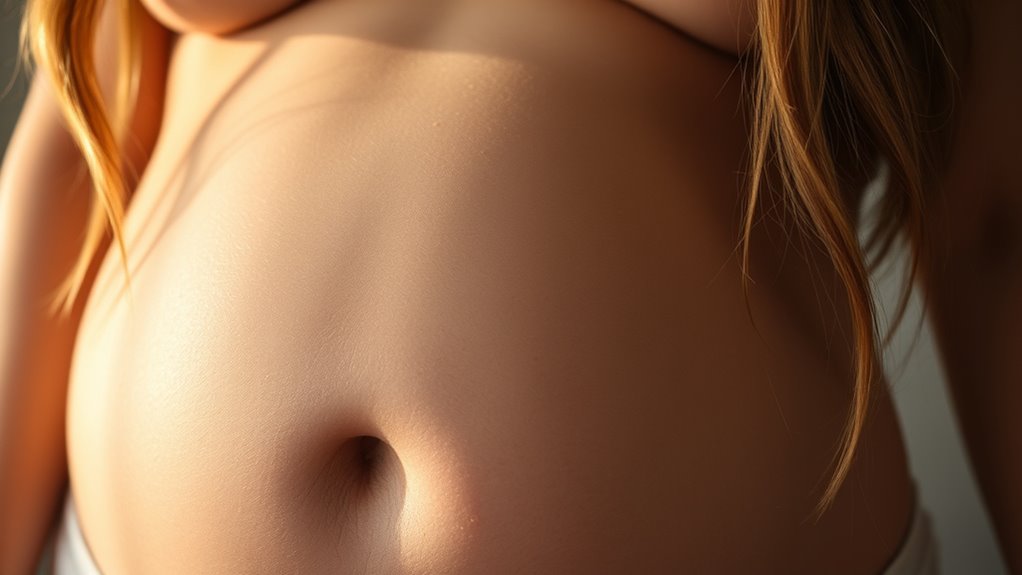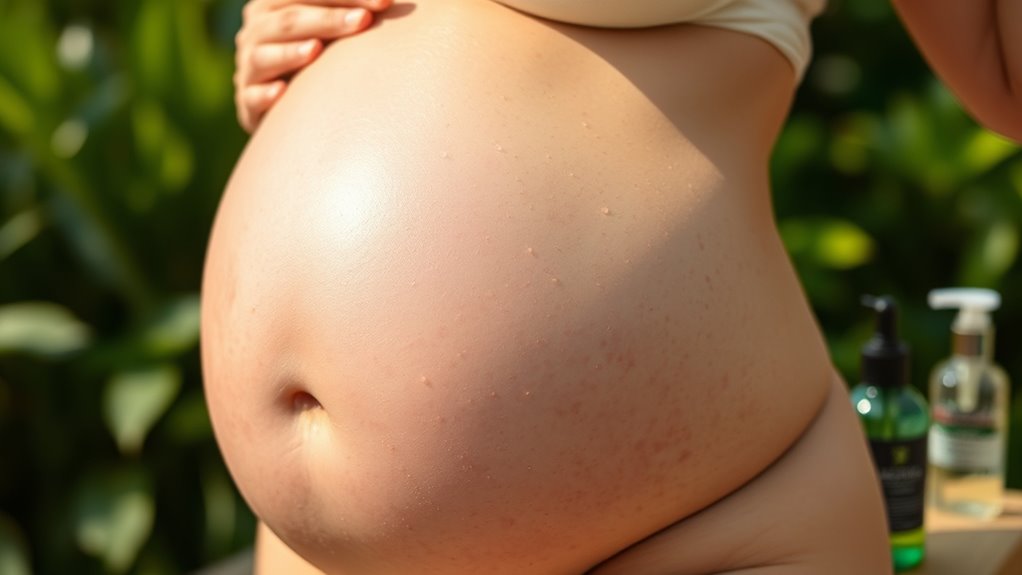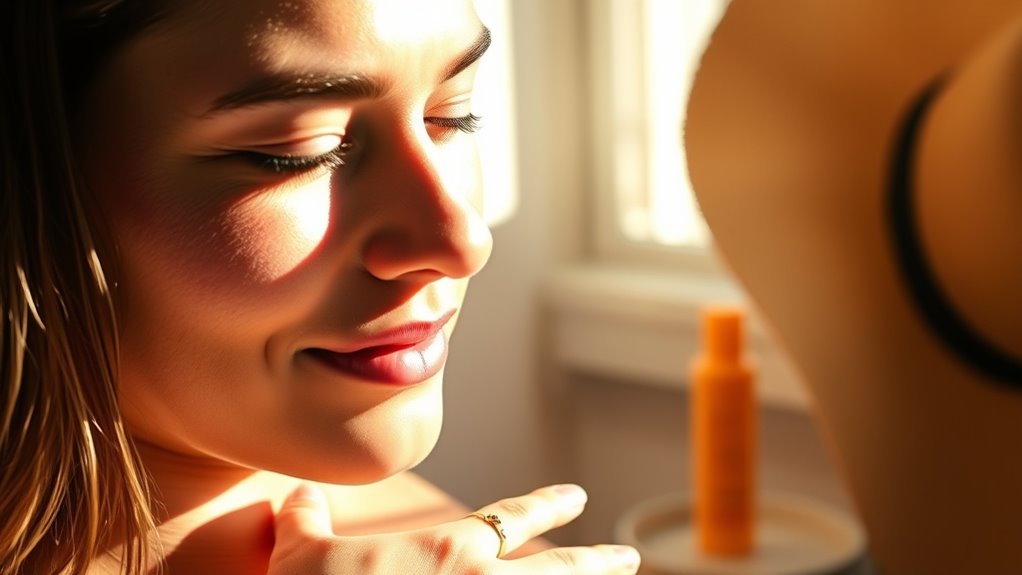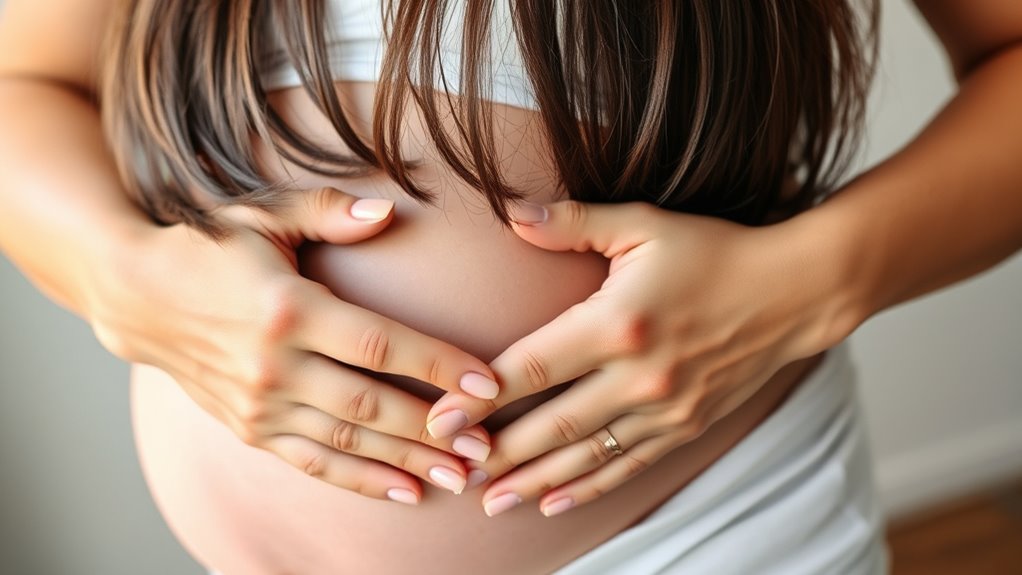During pregnancy, you’ll notice several skin changes that are completely normal. These can include melasma, stretch marks, increased oil leading to acne, and even a lovely pregnancy glow. Hormonal shifts and skin stretching cause these changes, so don’t worry; they’re common. It’s crucial to moisturize and protect your skin, especially against sun exposure. If you want to know how to care for your skin during this time or manage specific conditions, there’s more to discover.
Key Takeaways
- Melasma, or dark patches on the face, affects about 50% of pregnant individuals due to hormonal changes and increased sun exposure.
- Stretch marks occur in up to 90% of pregnant individuals from rapid skin expansion, initially appearing pink and fading to silver post-delivery.
- Acne may flare up during pregnancy due to hormonal fluctuations that increase blood flow and oil production.
- Spider veins develop from hormonal shifts and increased blood volume, contributing to vascular changes in the skin.
- A “pregnancy glow” is common due to enhanced blood circulation, improving skin appearance during pregnancy.
Common Skin Changes During Pregnancy

During pregnancy, your skin can undergo several noticeable changes, many of which are completely normal.
You’ll likely encounter common skin changes like melasma, where brown patches appear on your face. Stretch marks may develop due to rapid skin stretching, affecting up to 90% of pregnant individuals. These usually fade to faint silver lines after delivery, similar to how chia seeds promote skin hydration and elasticity. Incorporating products with glycolic acid can also help improve skin texture and tone during this time.
Acne might flare up in the first trimester as your blood flow and oil production increase. Additionally, spider veins and varicose veins can appear from hormonal shifts and increased blood volume, often resolving post-childbirth.
During the first trimester, increased blood flow may lead to acne and the appearance of spider veins or varicose veins.
You may notice skin tone changes, including dark spots or the darkening of nipples, but don’t worry—these typically return to normal after pregnancy, leaving you with that glorious pregnancy glow. Incorporating essential oils for skin health like lavender or eucalyptus may help soothe any discomfort related to these skin changes.
Causes of Skin Changes

During pregnancy, hormonal changes greatly impact your skin, leading to issues like dark spots and increased sensitivity. Additionally, coffee consumption is often linked to skin health benefits, which can be a consideration for pregnant individuals. As your body accommodates the growing fetus, skin stretching can result in stretch marks, affecting many pregnant individuals. Furthermore, increased blood volume can cause conditions such as spider veins, making these changes a common part of the pregnancy experience. Moreover, maintaining a balanced diet rich in nutrients like vitamins C and K can support skin health during this time. Furthermore, newborn safety guidelines recommend maintaining a smoke-free environment which can also help prevent skin irritations during pregnancy.
Hormonal Changes Impacting Skin
As your body undergoes the remarkable journey of pregnancy, hormonal changes considerably impact your skin. Elevated levels of estrogen and progesterone often lead to various skin changes.
You might notice melasma, where dark patches appear on your face due to stimulated melanocytes. Increased oil production can trigger acne, making your skin feel different. Consuming nutrient-dense foods like chia seeds can also support skin health during this time, as they are rich in omega-3 fatty acids which are beneficial for maintaining skin hydration and elasticity.
As your belly grows, hormonal fluctuations also affect skin elasticity, resulting in stretch marks. Additionally, you may experience vascular conditions like spider veins due to increased blood flow.
Notably, these hormonal changes can boost hair growth, making your hair thicker during pregnancy, although you might face shedding post-delivery as your hormone levels stabilize. Embracing these changes is essential, and incorporating healthy fruit juice varieties can further enhance your skin’s radiance during this unique journey!
Increased Blood Volume Effects
While your body adapts to the demands of pregnancy, increased blood volume considerably influences your skin’s appearance and health. This surge enhances circulation, often resulting in that coveted “pregnancy glow,” but it can also lead to skin issues like acne and oily skin. Hormonal fluctuations can stimulate oil production, causing breakouts. You might notice vascular changes, such as spider veins or varicose veins, due to increased pressure on your veins. Additionally, swelling, especially in your legs, can occur from non-pitting edema. Fortunately, these skin conditions typically resolve after childbirth. Exploring effective workflow strategies can help manage and mitigate these skin changes during pregnancy.
| Skin Changes | Description |
|---|---|
| Acne | Increased oil production leads to breakouts |
| Spider Veins | Enlarged blood vessels visible on skin |
| Varicose Veins | Swollen veins due to increased blood volume |
| Swelling | Fluid retention causes puffiness |
| Pregnancy Glow | Improved blood circulation enhances skin |
Skin Stretching Mechanisms
Pregnancy triggers significant hormonal changes that can lead to various skin alterations, including stretching.
These skin stretching mechanisms are primarily driven by:
- Increased blood volume and vascular changes, causing spider veins and varicose veins.
- Elevated levels of estrogen and progesterone, resulting in stretch marks due to rapid skin expansion.
- Enhanced melanin production, leading to dark spots and the pregnancy line.
As your body accommodates the growing fetus, skin elasticity can become compromised, especially in the abdomen, breasts, and thighs.
Stretch marks may affect up to 90% of pregnant individuals, often fading to silver lines post-delivery, but they mightn’t disappear entirely.
Understanding these common skin conditions can help you navigate the changes more confidently.
Acne Treatment Options

Managing acne during pregnancy can be challenging, but there are effective treatment options available to help you maintain clear skin. Start by washing your face twice daily with a mild cleanser and lukewarm water. Over-the-counter products containing benzoyl peroxide, azelaic acid, salicylic acid, and glycolic acid are generally safe to use, but always consult your healthcare provider first. Remember to avoid picking at acne and choose oil-free cosmetics to minimize breakouts.
Here’s a quick reference table for acne treatment options:
| Treatment Type | Safe to Use? | Recommendations |
|---|---|---|
| Mild Cleanser | Yes | Twice daily |
| Benzoyl Peroxide | Yes | Consult if unsure |
| Azelaic Acid | Yes | Effective for mild acne |
| Hormonal Therapy | No | Avoid during pregnancy |
| Dermatologist Consultation | Yes | For tailored advice |
Stretch Marks: Understanding and Management

Stretch marks are a common part of pregnancy, affecting many of you as your body undergoes rapid changes.
Understanding their causes and exploring prevention and treatment options can help you manage their appearance.
After delivery, it’s also important to know how to care for your skin as it adjusts postpartum.
Causes of Stretch Marks
As your body undergoes significant changes during pregnancy, you may notice the development of stretch marks, which occur when the skin stretches rapidly to accommodate the growing fetus.
Up to 90% of pregnant individuals experience these pinkish streaks, often appearing on the belly, breasts, and thighs.
Here are a few key causes of stretch marks:
- Rapid skin growth and stretching
- Hormonal changes affecting skin elasticity
- Genetic predisposition
While you can’t prevent or erase stretch marks completely, moisturizing can help reduce irritation and improve skin elasticity.
After delivery, these marks typically fade to faint silver lines, becoming less noticeable over time.
Understanding these skin changes can help you feel more prepared for your pregnancy journey.
Prevention and Treatment Options
While it’s impossible to completely prevent stretch marks during pregnancy, there are several strategies you can adopt to minimize their appearance and support your skin’s health.
Using moisturizers regularly can help reduce skin irritation caused by the rapid changes your body undergoes. Although no product guarantees prevention, keeping your skin hydrated may improve its elasticity.
You might also consider treatment options like topical treatments that claim to help, but remember that results vary.
After pregnancy, stretch marks typically fade to faint silver lines, becoming less noticeable over time. Embracing these marks as reminders of your pregnancy journey is common, as they reflect your body’s incredible adaptation to support your growing baby.
Postpartum Appearance and Care
After giving birth, you might notice that your body has changed in ways you didn’t expect, particularly with the appearance of stretch marks.
These marks are common in pregnancy and can appear on various areas, including your belly button, breasts, and thighs.
Here’s what you should know about postpartum skin changes:
- Stretch marks typically start as pinkish streaks and fade to faint silver lines.
- They affect up to 90% of pregnant women due to rapid skin stretching.
- Moisturizing may help reduce irritation, but it won’t prevent or erase stretch marks.
While stretch marks may not completely disappear, they often fade after the baby arrives, serving as a natural reminder of your journey into motherhood.
Melasma and Sun Protection

Melasma, often called the “mask of pregnancy,” can greatly affect your skin, leading to dark, uneven patches that appear primarily on your face.
This condition affects about 50% of pregnant individuals and is driven by hormonal changes and increased sun sensitivity.
To manage melasma, it’s essential to protect your skin from harmful UV rays. Always apply a broad-spectrum sunscreen with a high SPF, even on cloudy days.
Wearing protective hats when outdoors, especially between 10 a.m. and 2 p.m., can further shield your skin from sun damage.
Remember, unprotected sun exposure can worsen darkened areas and lead to other skin concerns.
Although these pigmentation changes may fade after delivery, prevention during pregnancy is important for maintaining healthy skin.
Itchiness and Dry Skin Relief

As your body changes during pregnancy, you might notice increased dryness and itchiness due to skin stretching. This discomfort can be annoying, but there are effective ways to find relief:
- Regularly moisturize your skin to combat dry skin.
- Use over-the-counter anti-itch cream for temporary relief of itchy skin.
- Try oatmeal baths to soothe irritation and severe itching.
If you experience severe itching along with nausea, vomiting, or jaundice, consult your doctor, as it could indicate intrahepatic cholestasis of pregnancy (ICP).
For conditions like pruritic urticarial papules and plaques (PUPP), oatmeal baths and prescribed treatments can help manage the discomfort.
Hair and Nail Changes During Pregnancy

During pregnancy, you may notice significant changes in your hair and nails, thanks to fluctuating hormones. Many experience thicker hair due to increased retention in the growth phase, giving it a fuller look. However, after childbirth, hair loss might occur around three months postpartum, known as telogen effluvium. Additionally, you might notice mild hair recession at the forehead and increased hair growth in new areas, termed hypertrichosis. Nail changes like brittleness and increased growth rate can also happen, along with various pigmentation changes, which typically resolve after delivery.
| Change Type | Description | Timeline |
|---|---|---|
| Hair Changes | Thicker, fuller appearance | Throughout pregnancy |
| Hair Loss | Telogen effluvium post-birth | ~3 months postpartum |
| Nail Changes | Increased growth, brittleness | Throughout pregnancy |
| Pigmentation Changes | Variations in nail color | Often resolves after childbirth |
Frequently Asked Questions
What Are the Normal Skin Changes During Pregnancy?
During pregnancy, you might notice several skin changes that are quite common.
You could experience increased pigmentation, leading to dark spots or melasma.
Stretch marks may appear as your body expands, especially on your belly and thighs.
Acne could flare up due to hormonal shifts, and you might develop spider or varicose veins.
Additionally, your hair may become thicker, and your nails might grow faster, often returning to normal after childbirth.
What Are 5 Warning Signs of a Possible Problem During Pregnancy?
Like a warning bell in the night, certain signs during pregnancy shouldn’t be ignored.
If you experience severe itching along with nausea, it could signal a serious liver issue.
Blisters or large bumps might indicate an autoimmune condition.
Watch for persistent acne or worsening skin conditions needing medical advice.
Sudden varicose veins can suggest increased pressure.
Finally, notice any changes in moles; they warrant a professional evaluation to rule out skin concerns.
What Are the 4 Cutaneous Changes in Pregnancy?
During pregnancy, you might notice four common cutaneous changes.
First, increased pigmentation can create dark patches on your face, known as melasma.
You may also see stretch marks as your skin expands, often appearing on your belly and breasts.
Acne could flare up due to hormonal shifts.
Finally, you might develop spider and varicose veins from increased blood volume and pressure, which usually fade post-delivery.
These changes are quite common and often temporary.
What Is the Most Common Skin Condition in Pregnancy?
In the dance of life, your skin may reveal unexpected patterns.
The most common skin condition you might encounter during pregnancy is melasma, often called “the mask of pregnancy.” It manifests as dark, splotchy patches on your face, a reminder of the changes your body is embracing.
As your body transforms, stay aware of these shifts; they’re part of the beautiful journey into motherhood, reflecting the vibrant life growing within you.
Conclusion
To sum up, pregnancy brings a whirlwind of skin changes, and it’s completely normal to experience them. Did you know that up to 90% of women develop stretch marks during this time? Embracing these changes is part of the journey, and with the right care, you can manage them effectively. Remember, each mark tells a story of your unique experience. So, enjoy this transformative phase and take good care of your skin!









